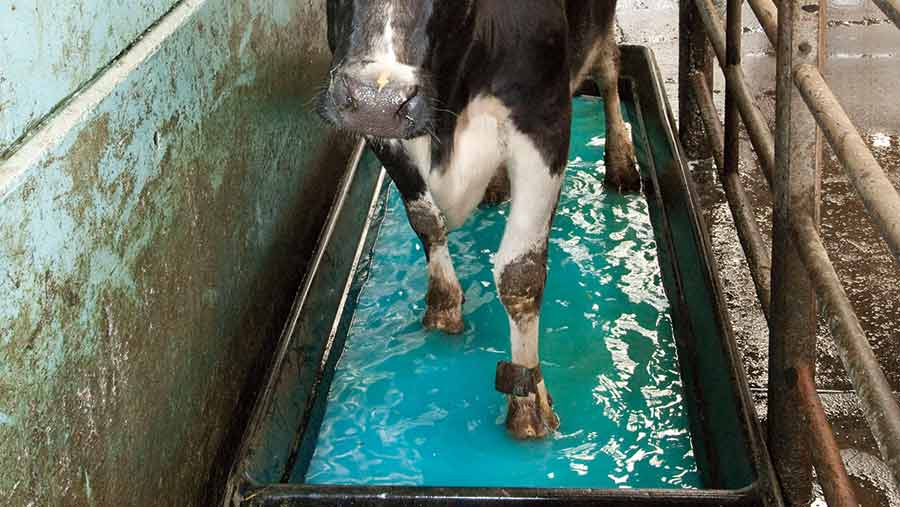Top 10 tips to help avoid cow lameness in winter months
Lameness is one of the three main challenges facing dairy farmers all year, but at housing the risk is heightened.
Owen Atkinson from Dairy Veterinary Consultancy gives his top 10 tips to help avoid lameness during the winter months.

© FLPA/Rex/Shutterstock
1. Review lameness treatment protocols
When faced with a lame cow exhibiting an AHDB Dairy mobility score of 2 or 3, farmers generally trim and apply a block.
However, recent research by Nottingham University has demonstrated the benefit of a three-pronged approach comprising a trim, block and non-steroidal anti-inflammatory (Nsaid) Ketoprofen treatment. When using this approach, cows have been proven to be significantly more likely not to be lame five weeks later.
Nsaids play a vital role in any treatment, as they work as an analgesic, anti-pyretic and anti-inflammatory.
I would advise farmers to consult with their vet to incorporate them into the lameness plan, as part of an early, effective treatment protocol to improve recovery rates and reduce the chances of cows becoming lame again in the future.
See also: Combination treatments help cut lameness
2. Treat any reoccurring cases of digital dermatitis
Digital dermatitis (DD) generally lies dormant over the summer and often only becomes noticeable when cows come in contact with slurry. This is more of a problem at housing, so treatment plans need to be in place.
Cows prone to DD act as a reservoir of infection, so monitor hooves in the parlour, and individually treat any cases promptly before infection spreads.
3. Review winter housing foot-bathing protocol
Before housing is the perfect time to review your approach to foot-bathing, as it is an essential part of lameness control wherever infection such as DD occurs.
More important than the product and the frequency is the bath itself.
Make sure it is fit for purpose and the floor isn’t slippery or uncomfortable. It should be at least 3m in length so the cows can comfortably walk through it with two strides.
See also: Eight steps to improve dairy herd foot-bathing regime
4. Effective mobility scoring of cows
Most farmers understand the importance of accurate and regular mobility scoring of cattle as part of any herd lameness plan.
With AHDB’s scoring system, identifying score 3 cows is commonly done. However, score 2 animals are more difficult to spot, yet require immediate attention.
You should have at least one person on farm who has been trained to score, and record the scores for future monitoring.
5. Accurately body condition score the herd
Body condition scoring (BCS) is commonly done to monitor all-round herd health, but recently a connection has been made between thin cows, with a score of less than 2.5, and an increased risk of lameness.
Most farmers score their herd’s body condition, but few record the data and use it for monitoring cows over time.
Apps such as BCS Cowdition by Bayer Animal Health allow farmers to accurately score and record the data so it can be shared with the vet and others on farm. This allows effective treatment and monitoring to be undertaken.
6. Have a general first aider on farm to administer early treatment
If a cow is lame she needs immediate treatment.
If the foot trimmer isn’t coming for another week, you need to have someone on farm who can confidently identify the lameness issue and then be able to trim, apply a block and administer NSAID, as required.
You also need the facilities to do this easily and safely.
7. Manage heifer integration to the herd
Once a cow experiences lameness, research has shown they are at a higher risk of the problem reoccurring.
Farmers should keep this in mind when managing heifers as a priority for herd longevity, such as acclimatising heifers to concrete floor before calving.
8. Undertake pre-housing cubicle repairs
Farmers should maintain and repair what is already on farm where appropriate, but it is important to ensure sufficient shed space is allowed a cow.
Focus on cow comfort and make sure the cubicle surfaces are repaired if broken or worn and that the bedding is deep, soft and provides grip.
See also: 5 tips to prepare for dairy winter housing
9. Review slurry management
Slurry is the perfect home for bacteria that cause DD, therefore, effective management of it in the buildings is essential.
Monitor the frequency of the automated scrapers to see if it needs to be increased, incorporate manual scraping if necessary and repair any broken concrete floors.
10. Ensure all equipment is fit for purpose
Before housing is a good time to take stock of trimming equipment.
Check all knives are sharp and safe to use and stock up on blocks, NSAIDs and bandages.
Make sure the crush is suitable for use by one person – it should only take one person one minute to get one cow in the crush safely.
